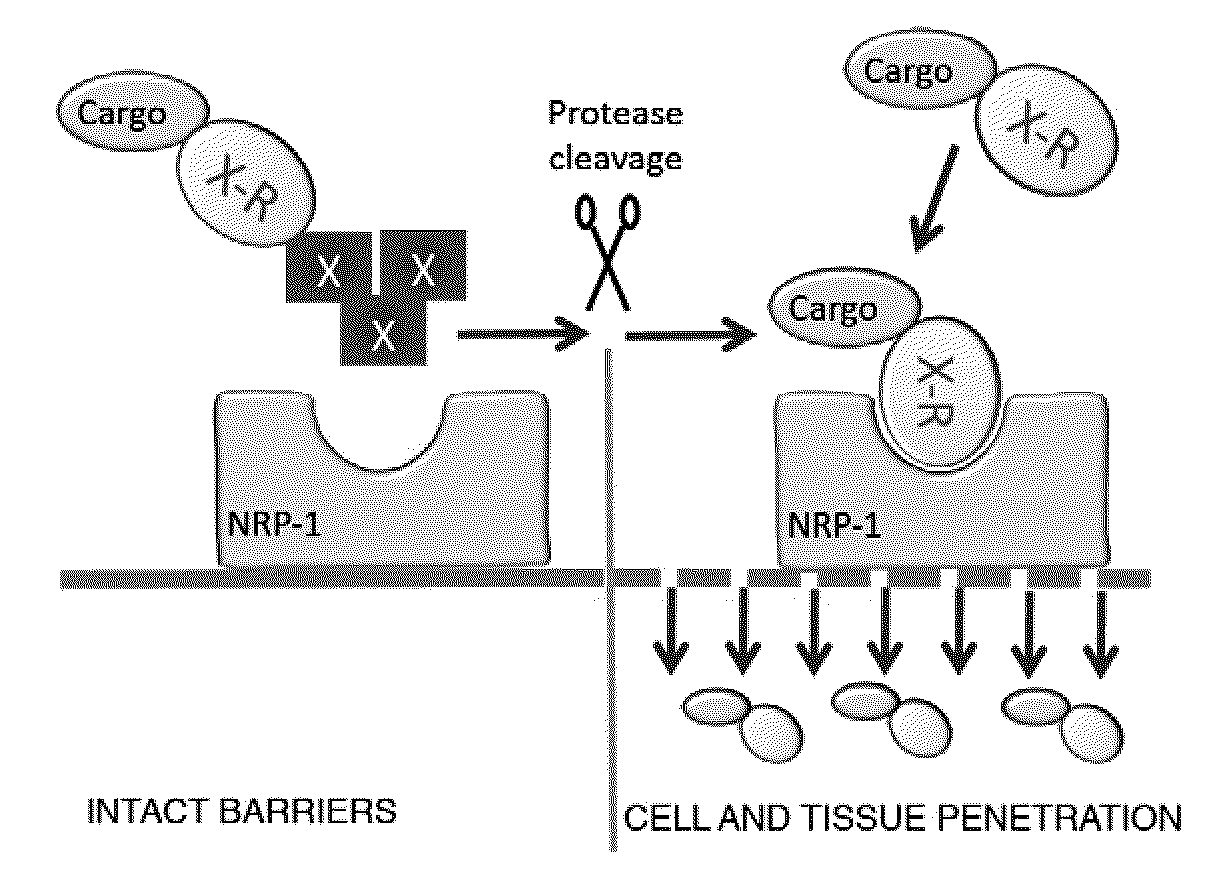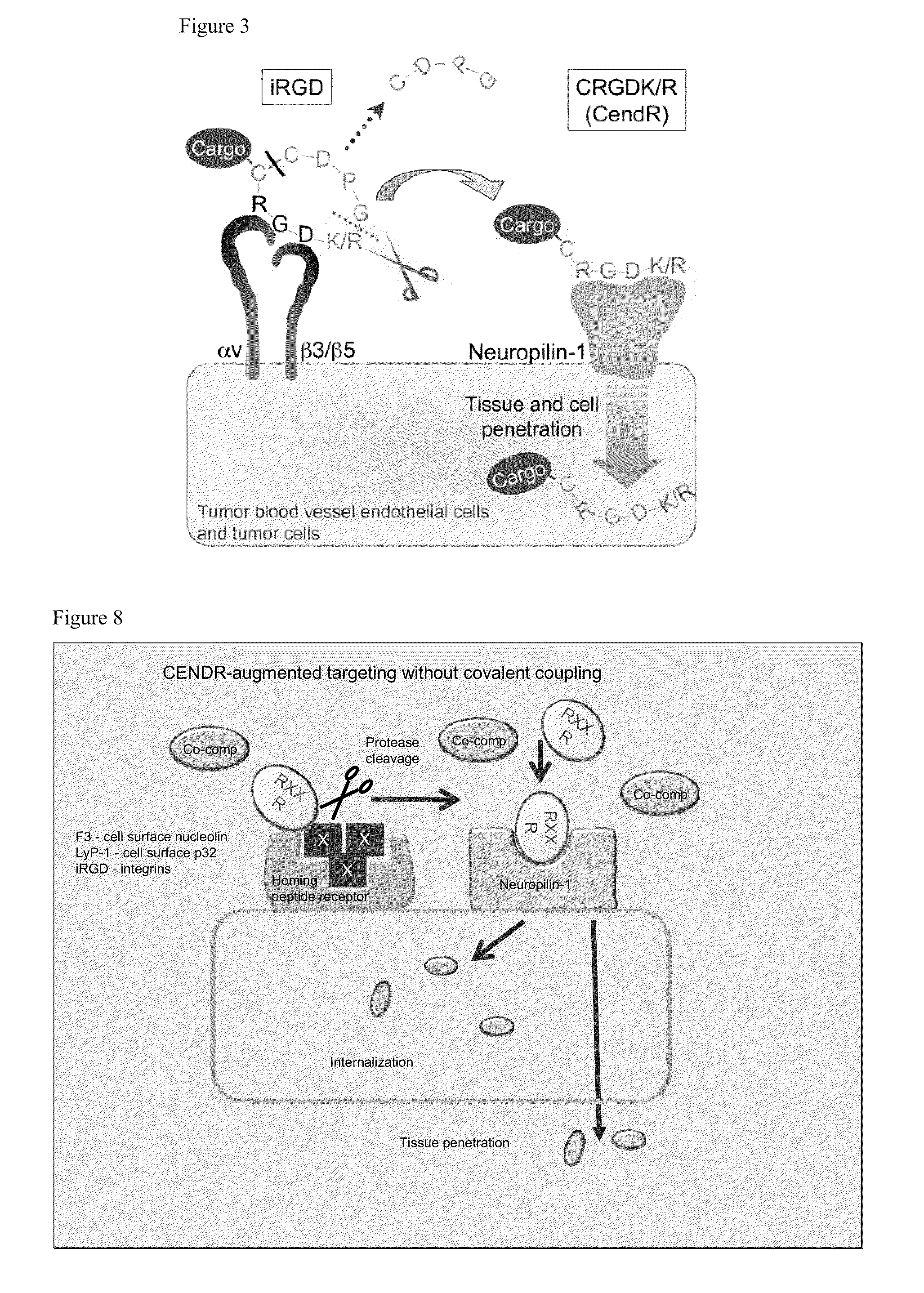Methods and compositions using peptides and proteins with c-terminal elements
a technology of c-terminal elements and peptides, applied in the field of molecular medicine, can solve the problems of not selective, tissue penetration is a serious limitation in the delivery of compositions to cells, and does not appear to substantially mitigate this problem, so as to enhance the internalization and and enhance the penetration of co-composition into or through tissue.
- Summary
- Abstract
- Description
- Claims
- Application Information
AI Technical Summary
Benefits of technology
Problems solved by technology
Method used
Image
Examples
example 1
A. Example 1
Cell Internalization and Tissue Penetration of Co-Composition Mediated by CendR Peptide
[0394]To demonstrate the ability of systemically administered CendR peptides to cause vascular leakage (and thus enhance cell internalization and tissue penetration of a co-composition), oligomeric RPARPAR-neutravidin complexes (SEQ ID NO:2) were intravenously injected and tissue distribution of co-injected tracer phage was determined In this assay, the blood is removed by perfusion, and the extravasated blood constituents, including the tracer phage, remain in tissues. Oligomeric RPARPAR (SEQ ID NO:2), but not oligomeric control peptide, caused increased retention of the phage in lungs and other organs, in line with increased extravasation of the phage particles (FIG. 2). These data show that RPARPAR peptides are able to promote tissue penetration of both attached payloads and to permeabilize tissues to allow entry of macromolecules, such as co-compositions administered or present.
example 2
B. Example 2
Tumor Penetration and Permeabilization Using Homing CendR Peptides
[0395]FIG. 3 depicts the principle of the CendR system as it applies to a tumor-homing RGD peptide dubbed iRGD (sequence: CRGDK / RGPD / EC; SEQ ID NO:61). The two motifs in iRGD are the RGD motif (Ruoslahti, 2002), which mediates the binding of the peptide to αv integrins on tumor endothelium and a cryptic CendR sequence RGDK (or RGDR; SEQ ID NO:229). The RGD homing sequence directs the peptide to tumor endothelium (angiogenic vasculature expresses αv integrins), where the peptide is proteolytically processed by an endogenous protease, such that the CendR motif becomes C-terminal and active. The activated CendR motif then binds to a different receptor (neuropilin-1; Teesalu et al., 2009; U.S. patent Ser. No. 12 / 355,672, filed Jan. 19, 2009), which mediates extravasation, tumor penetration, and cell entry of the C-terminally truncated peptide (and any payload attached to it). Each of these steps has been docum...
example 3
C. Example 3
Targeting Tumors by Inducing a Tumor-Selective Vascular Permeabilization
[0431]A major problem of cancer therapy is that anti-cancer agents do not adequately penetrate into tumor tissue. Here, a conceptually new approach is introduced that overcomes this limitation. A tumor-penetrating peptide, iRGD (CRGDK / RGPD / EC; SEQ ID NO:61), that selectively increases vascular escape and tumor penetration of co-administered compounds of various sizes is disclosed. This activity depends on two sequence motifs within iRGD, the RGD binding motif for αv integrins, which are expressed in tumor vessels (and often on tumor cells) and the RXXR / K C-end Rule motif that binds to a tissue-penetration receptor, neuropilin-1. Co-administration with iRGD increased the anti-tumor activity of two drugs (doxorubicin liposomes and Herceptin). iRGD can be utilized as a generic booster of cancer diagnostics and therapeutics.
[0432]Current anti-cancer agents suffer from two main problems: poor penetration ...
PUM
| Property | Measurement | Unit |
|---|---|---|
| co-composition | aaaaa | aaaaa |
| cargo composition | aaaaa | aaaaa |
| composition | aaaaa | aaaaa |
Abstract
Description
Claims
Application Information
 Login to View More
Login to View More - R&D
- Intellectual Property
- Life Sciences
- Materials
- Tech Scout
- Unparalleled Data Quality
- Higher Quality Content
- 60% Fewer Hallucinations
Browse by: Latest US Patents, China's latest patents, Technical Efficacy Thesaurus, Application Domain, Technology Topic, Popular Technical Reports.
© 2025 PatSnap. All rights reserved.Legal|Privacy policy|Modern Slavery Act Transparency Statement|Sitemap|About US| Contact US: help@patsnap.com



